http://www.spacedaily.com/reports/Russia_to_create_new_Super_Heavy_Class_rocket_after_2025_999.htmlRussian Deputy Prime Minister Dmitry Rogozin stated that Russian President Vladimir Putin posed the task before Roscosmos to speed up creating a super-heavy class rocket.
Russian President Vladimir Putin has asked the Roscosmos state space corporation to speed up the work to build a super-heavy class rocket, this type will appear after 2025 and will make it possible to fly around the moon, Deputy Prime Minister Dmitry Rogozin said Monday.
"The president was talking about the prospect of creating a super-heavy class rocket. The president posed the task before Roscosmos to speed up this work by developing all those technologies that were presented by the general designers," Rogozin told journalists after a meeting with the Russian president, adding that "it will be a new stage of manned space exploration."
Install the app
How to install the app on iOS
Follow along with the video below to see how to install our site as a web app on your home screen.
Note: This feature may not be available in some browsers.
You are using an out of date browser. It may not display this or other websites correctly.
You should upgrade or use an alternative browser.
You should upgrade or use an alternative browser.
Avaruus
- Viestiketjun aloittaja Juke
- Aloitus PVM
tulikomento
Supreme Leader
Tässä kuuluisa videopätkä Saturn 5 -kantoraketin ensimmäisestä miehittämättömästä koelaukaisusta. CBS:n uutisankkuri Walter Cronkite spiikkaa. Tuossa kuulee kuinka uutisryhmän käyttämän rakennuksen ikkunatkin helisevät, vaikka laukaisualustalle on matkaa useampi kilometri.
Ilmeisesti laukaisualustalla ei vielä tuolloin käytetty vesivaimennusta ja tämän takia ääni oli todella mahtava. Youtuben kommenteissa on mainio toteamus: "Dudes got hard,women had orgasms."
Ilmeisesti laukaisualustalla ei vielä tuolloin käytetty vesivaimennusta ja tämän takia ääni oli todella mahtava. Youtuben kommenteissa on mainio toteamus: "Dudes got hard,women had orgasms."

fulcrum
Greatest Leader
Vesivaimennus otettiin käyttöön ensimmäisen sukkulalennon jälkeen. Laukaisukompleksin betonista takaisin heijastuvat ääniaallot olivat niin kovia että ne vaurioittivat pahasti sukkulan lämpösuojausta ja ohjainpintoja. Lennolla mukana ollut astronautti kertoi myöhemmin että jos he olisivat tienneet miten pahasti sukkula vaurioitui lähdössä, he olisivat käyttäneet heittoistuimiaan saman tien.
tulikomento
Supreme Leader
Vesivaimennus otettiin käyttöön ensimmäisen sukkulalennon jälkeen. Laukaisukompleksin betonista takaisin heijastuvat ääniaallot olivat niin kovia että ne vaurioittivat pahasti sukkulan lämpösuojausta ja ohjainpintoja. Lennolla mukana ollut astronautti kertoi myöhemmin että jos he olisivat tienneet miten pahasti sukkula vaurioitui lähdössä, he olisivat käyttäneet heittoistuimiaan saman tien.
Tosiaan, sukkulaohjelman alkuvaiheessahan sukkulassa oli heittoistuimet.
https://en.wikipedia.org/wiki/Space_Shuttle_abort_modes#Ejection_escape_systems
Liitotesteihin käytetyssä Enterprisessä ja ensimmäisessä operatiivisessa sukkulassa Columbiassa siis. Wikin mukaan sama penkki kuin SR-71 Blackbirdissäkin. Myös 60-luvun puolivälin Gemini -kapselissa oli heittoistuimet.
fulcrum
Greatest Leader
Jotenkin takaperoista kehitystä että pelastusmekanismit poistetaan avaruusaluksesta. Jotkut avaruushistorioitsijat ovat sitä mieltä että jokainen sukkulalaukaisu Challenger-onnettomuuteen asti oli ns. vaarallinen läheltä piti-tilanne. Toisaalta, heittoistuimet eivät olisi auttaneet kummassakaan todellisessa sukkulaonnettomuudessa. Sukkulan oli vaan toimittava, koska ilman muuta se toimisi, vai kuinka? Sojuz oli tässä suhteessa etevämpi, siinä on keskeytysmoodit lennon joka vaiheessa kiertoradalle asti, ja kaikki ovat ainakin teoriassa sellaisia että miehistö selviäisi. Kahdesti niitä on jouduttu kokeilemaankin. Tämä asettaa myös minimitason tulevaisuuden ratkaisuille, vastaisuudessa ei tulla enää kelpuuttamaan miehitettyjä avaruusaluksia ilman kunnollisia abort modeja.
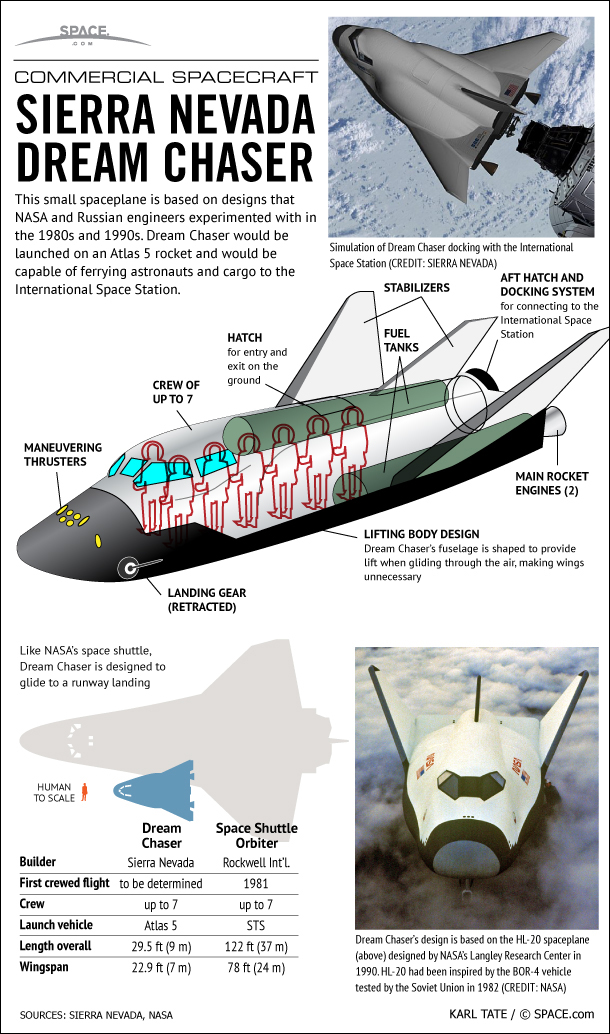
http://www.spacedaily.com/reports/Dream_Chaser_Spacecraft_Passes_Major_Milestone_999.htmlSierra Nevada Corporation (SNC) successfully passed the third integration milestone for the Dream Chaser program under the NASA Commercial Resupply Services (CRS2) program, bringing it a major step closer to providing resupply services to the International Space Station (ISS).
CRS2 Integration Review #3 (IR3) confirmed SNC's Dream Chaser Cargo System design meets NASA's key requirements and maximizes probability of mission success during future flights. The spacecraft is scheduled for at least six missions between 2019 and 2024.
l
Mikoyan
Ylipäällikkö
Aiemmin ketjussa mainitsemani Stratolaunch on sittenkin valmistumassa;
http://www.tiedetuubi.fi/videot/video-jattimainen-stratolaunch-lentokone-esiteltiin
Tässä on lentokoneella kokoa!
Siipien kärkiväli on 117 metriä, eli kyseessä on tällä mittapuulla laskettuna maailman suurin lentokone. Pyöriä lentokoneen laskutelineissä on 28.
Stratolaunch on kuusimoottorinen ja kaksirunkoinen lentokone, jonka tarkoituksena on toimia ilmasta avaruuteen laukaistavien kantorakettien lähetysalustana. Se on lähes kokonaan komposiittirakenteinen, ja sen osia on otettu kahdesta tätä varten puretusta Boeing 747 Jumbo jetistä.
Kannibalisoimalla moottorit, avioniikkaa, ohjaamot, laskutelineet ja muita osia kahdesta Jumbosta yhtiö on säästänyt pitkän pennin lentokoneen rakennuskustannuksissa.
Lentokoneen koelennot aloitetaan vielä tänä vuonna ja tarkoituksena on aloittaa rutiininomaiset laukaisut vuonna 2020. Ensimmäinen testilaukaisu tehdään näillä näkymin vuonna 2019.
Kone nousee lentoon aikanaan suuri raketti kahden runkonsa välissä ilmaan, lentää noin 15 kilometrin korkeuteen ja pudottaa raketin siellä irralleen. Hetken kuluttua – kun lentokone on kaartanut etäämmälle – raketti sytyttää moottorinsa ja kuljettaa nokassaan olevan satelliitin avaruuteen.
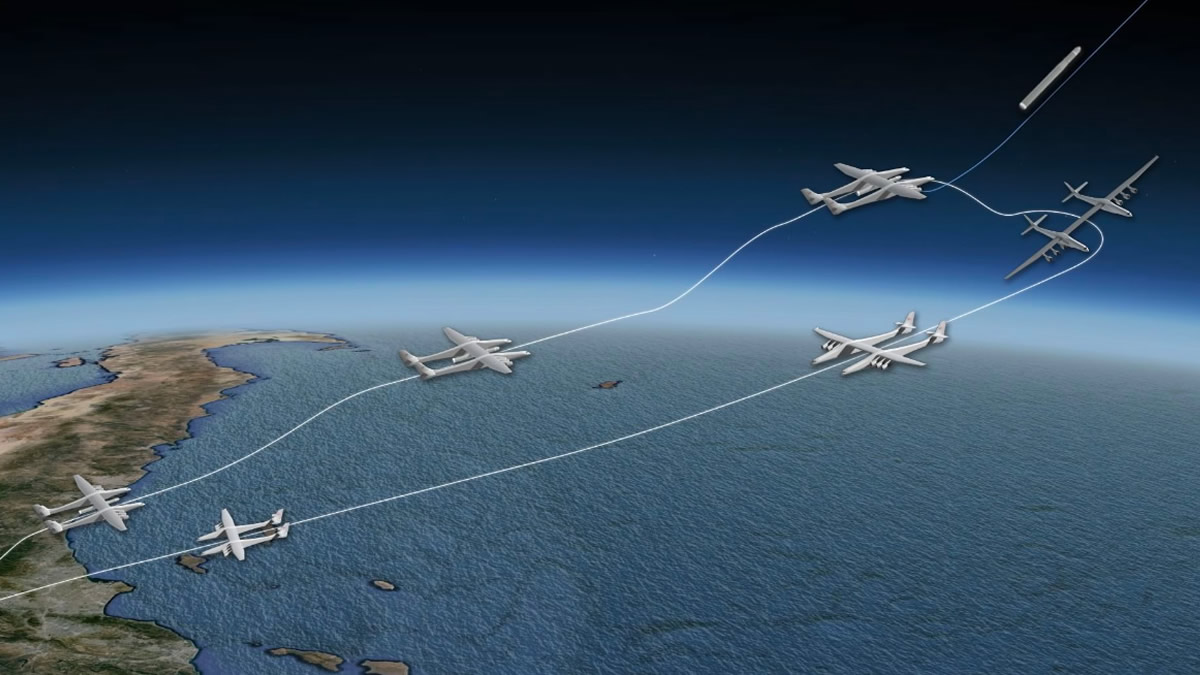
Kyseessä on yksi monista kokonaan uusista kantorakettisysteemeistä, jotka tulevat tekemään satelliittien lähettämisestä paljon nykyistä edullisempaa ja kätevämpää.
Hanke julkistettiin vuonna 2011. Sen päärahoittajana on Microsoft-miljardööri Paul Allen, jonka lisäksi 300 miljoonaa dollaria alkupääomaa vaatineessa hankkeessa on mm. Scaled Composites. Scaled vastaa koneen suunnittelusta ja komposiittiosien tekemisestä, eikä siksi ole mikään ihme, että se muistuttaa kovasti SpaceShip2-alusta kuljettavaa White Knight -lentokonetta.
Jättikoneen massa on 226 800 kg, sen pituus on 72,5 metriä ja korkeus 15,2 metriä.
Se on suunniteltu kantamaan noin 250 tonnia massaltaan olevaa kantorakettia, eli suurimmillaan täyteen tankattu kone ja sen kuorma painavat noin 590 tonnia. Sen toimintasäde on noin 2200 km.
Tarkoituksena oli tehdä ensilento koneella jo vuonna 2015, mutta hanke on hieman myöhässä.
Lähiviikkoina lentokonetta testataan maassa, sitten sillä tehdään rullauskokeita ja lopulta kesän jälkeen on vuorossa ensilento. Koneen testaamiseen ja lentokelpuuttamiseen menee koko ensi vuosi, joten ensimmäiseen laukaisuun päästään vasta kahden vuoden päästä – jos kaikki sujuu hyvin.
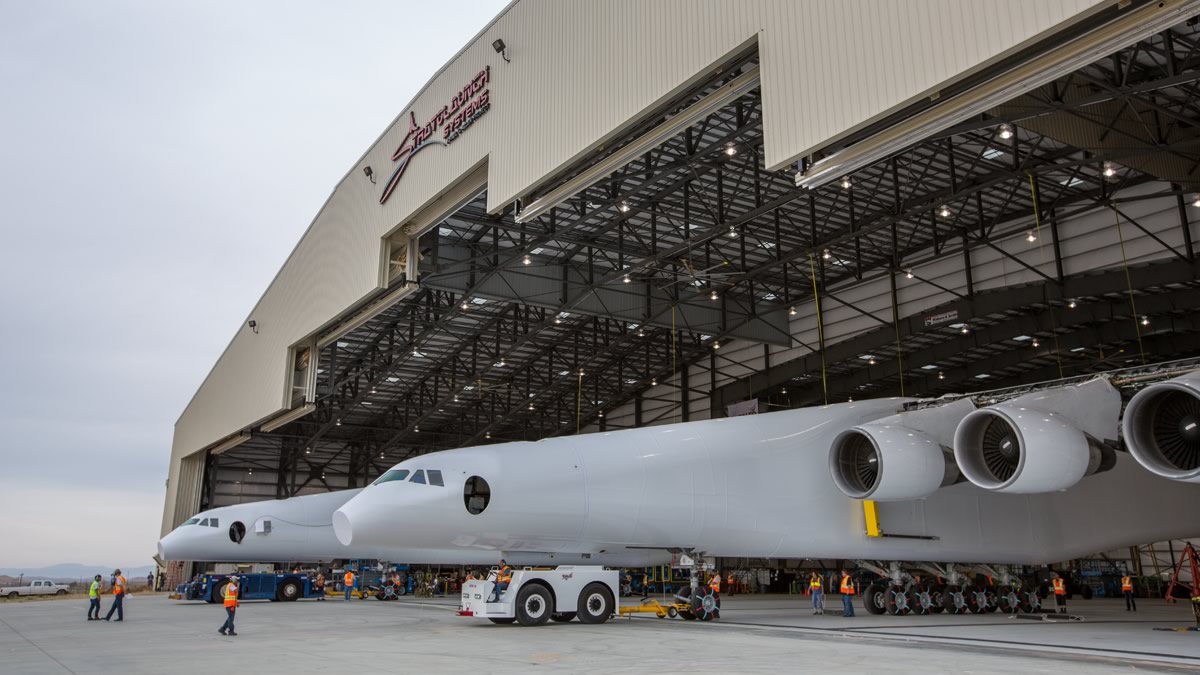
Stratolaunchin hangaari on Kaliforniassa Mojavessa, mutta aikanaan kone voi laukaista raketteja matkaan lähes mistä vain, missä on tarpeeksi pitkä kiitorata ja sopiva paikka raketin laukaisuvalmisteluille.
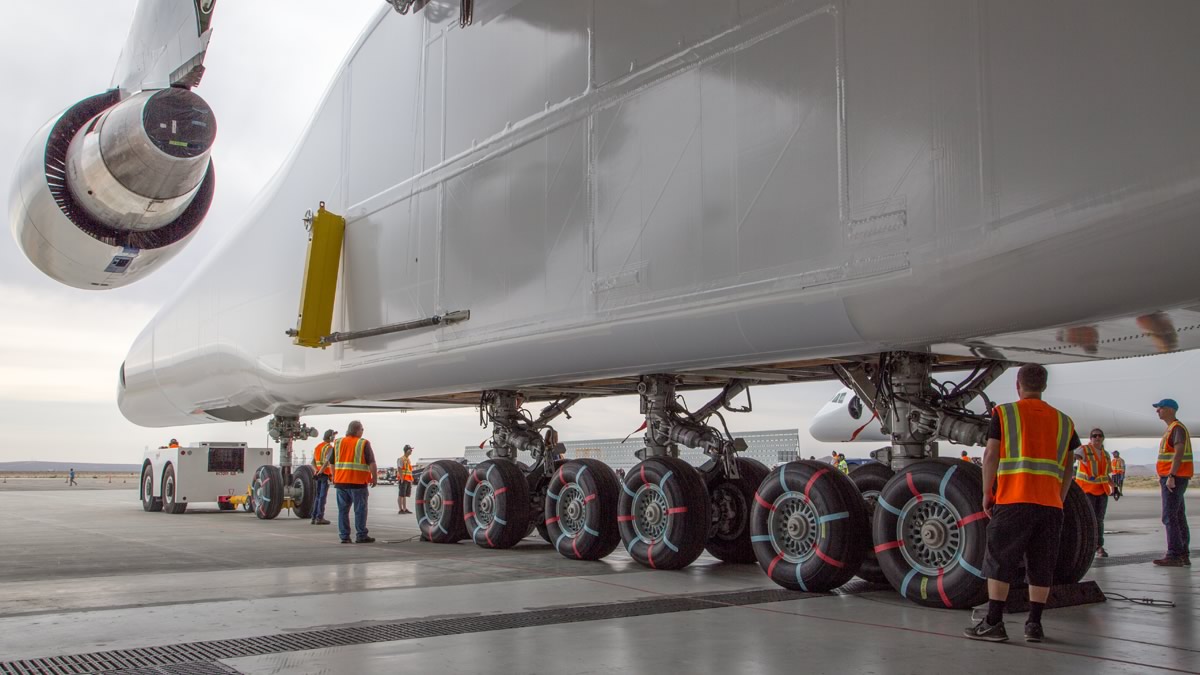
Ensimmäisellä laukaisulla käytetään jo koeteltua ja hyväksi havaittua pientä Pegasus XL -rakettia, jota valmistellaan jo lentoa varten. Ennen laukaisua lentokonetta kun pitää testata perusteellisesti myös siten, että sen kyydissä on täysipainoinen raketti.
Aikanaan laukaisuihin tullaan käyttämään suurempaa ja kyvykkäämpää kantorakettia, mutta sen tyypistä ei yhtiö kerro vielä mitään. Alun perin Stratolaunch oli yhteistyössä Space X:n kanssa, mutta yhtiöiden tiet erosivat vuonna 2015, kun kumpikin halusi keskittyä tekemään laukaisuita omalla tavallaan.
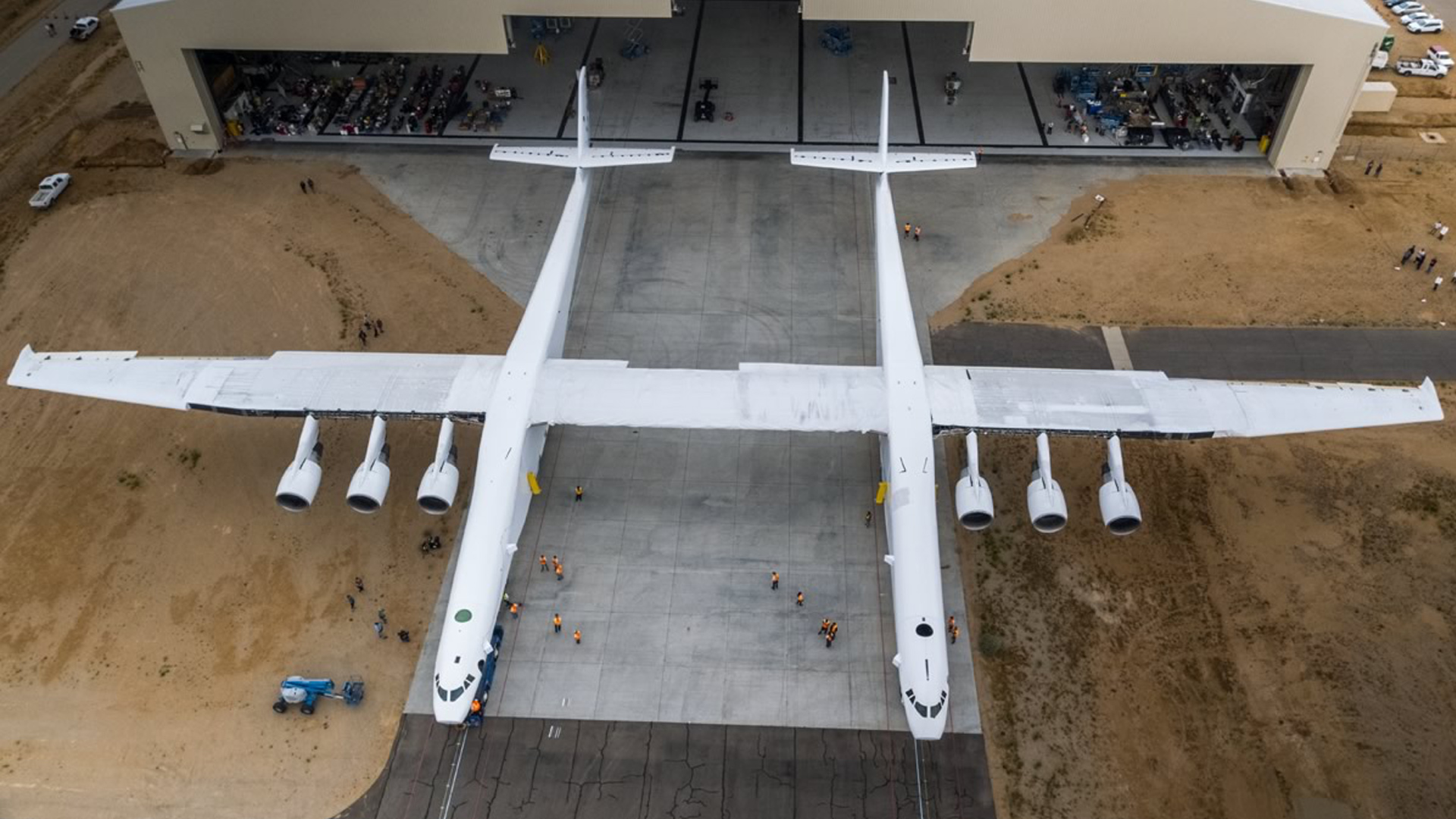
http://www.tiedetuubi.fi/videot/video-jattimainen-stratolaunch-lentokone-esiteltiin
Tässä on lentokoneella kokoa!
Siipien kärkiväli on 117 metriä, eli kyseessä on tällä mittapuulla laskettuna maailman suurin lentokone. Pyöriä lentokoneen laskutelineissä on 28.
Stratolaunch on kuusimoottorinen ja kaksirunkoinen lentokone, jonka tarkoituksena on toimia ilmasta avaruuteen laukaistavien kantorakettien lähetysalustana. Se on lähes kokonaan komposiittirakenteinen, ja sen osia on otettu kahdesta tätä varten puretusta Boeing 747 Jumbo jetistä.
Kannibalisoimalla moottorit, avioniikkaa, ohjaamot, laskutelineet ja muita osia kahdesta Jumbosta yhtiö on säästänyt pitkän pennin lentokoneen rakennuskustannuksissa.
Lentokoneen koelennot aloitetaan vielä tänä vuonna ja tarkoituksena on aloittaa rutiininomaiset laukaisut vuonna 2020. Ensimmäinen testilaukaisu tehdään näillä näkymin vuonna 2019.
Kone nousee lentoon aikanaan suuri raketti kahden runkonsa välissä ilmaan, lentää noin 15 kilometrin korkeuteen ja pudottaa raketin siellä irralleen. Hetken kuluttua – kun lentokone on kaartanut etäämmälle – raketti sytyttää moottorinsa ja kuljettaa nokassaan olevan satelliitin avaruuteen.

Kyseessä on yksi monista kokonaan uusista kantorakettisysteemeistä, jotka tulevat tekemään satelliittien lähettämisestä paljon nykyistä edullisempaa ja kätevämpää.
Hanke julkistettiin vuonna 2011. Sen päärahoittajana on Microsoft-miljardööri Paul Allen, jonka lisäksi 300 miljoonaa dollaria alkupääomaa vaatineessa hankkeessa on mm. Scaled Composites. Scaled vastaa koneen suunnittelusta ja komposiittiosien tekemisestä, eikä siksi ole mikään ihme, että se muistuttaa kovasti SpaceShip2-alusta kuljettavaa White Knight -lentokonetta.
Jättikoneen massa on 226 800 kg, sen pituus on 72,5 metriä ja korkeus 15,2 metriä.
Se on suunniteltu kantamaan noin 250 tonnia massaltaan olevaa kantorakettia, eli suurimmillaan täyteen tankattu kone ja sen kuorma painavat noin 590 tonnia. Sen toimintasäde on noin 2200 km.
Tarkoituksena oli tehdä ensilento koneella jo vuonna 2015, mutta hanke on hieman myöhässä.
Lähiviikkoina lentokonetta testataan maassa, sitten sillä tehdään rullauskokeita ja lopulta kesän jälkeen on vuorossa ensilento. Koneen testaamiseen ja lentokelpuuttamiseen menee koko ensi vuosi, joten ensimmäiseen laukaisuun päästään vasta kahden vuoden päästä – jos kaikki sujuu hyvin.

Stratolaunchin hangaari on Kaliforniassa Mojavessa, mutta aikanaan kone voi laukaista raketteja matkaan lähes mistä vain, missä on tarpeeksi pitkä kiitorata ja sopiva paikka raketin laukaisuvalmisteluille.

Ensimmäisellä laukaisulla käytetään jo koeteltua ja hyväksi havaittua pientä Pegasus XL -rakettia, jota valmistellaan jo lentoa varten. Ennen laukaisua lentokonetta kun pitää testata perusteellisesti myös siten, että sen kyydissä on täysipainoinen raketti.
Aikanaan laukaisuihin tullaan käyttämään suurempaa ja kyvykkäämpää kantorakettia, mutta sen tyypistä ei yhtiö kerro vielä mitään. Alun perin Stratolaunch oli yhteistyössä Space X:n kanssa, mutta yhtiöiden tiet erosivat vuonna 2015, kun kumpikin halusi keskittyä tekemään laukaisuita omalla tavallaan.

Viimeksi muokattu:
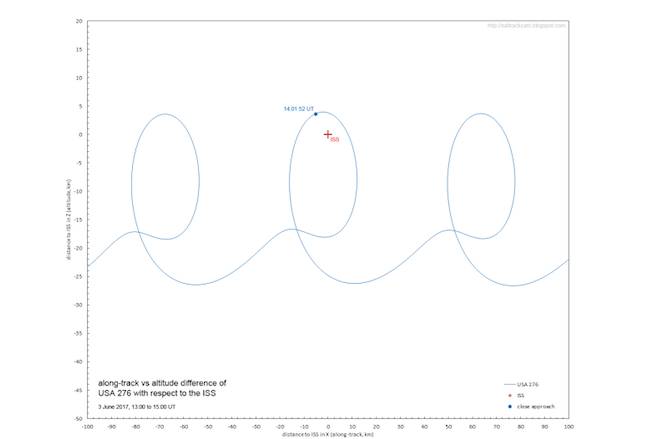
http://www.theregister.co.uk/2017/06/08/national_reconnaissance_office_satellite_flew_past_iss/For a little while earlier this month, astronauts on the International Space Station had a spooky companion: a spy satellite that circled just outside its “danger zone”.
Dutch satellite-watcher Marco Langbroek (whose day job is at Leiden University) analysed the orbit of USA 276, a spy satellite owned by the US National Reconnaissance Office and hoisted aboard the May 1 SpaceX mission.
It's something of a vindication for the (now) amateur astronomer, since in late May he speculated that a close approach was feasible.
Just such a pass came to pass happened on June 3, and after doing the mathematics on the orbit, Langbroek reckons the spy-sat came within 6.4 km of the ISS – with a ±2 km error margin.
(That margin is so large, he explains, because TLE, the two-line element set that describes a satellite's orbit, has a typical 1 km positional accuracy.)
For a few of the approaches Langbroek analysed, the satellite circled the ISS in two plans – both laterally (cross-track) and along-track.
Hyvä, hyvä, hyvä 

http://www.theregister.co.uk/2017/06/23/ai_crucial_nasa/Autonomous space robots are going to be key to making new discoveries and exploring the furthest reaches of our Solar System and beyond, according to NASA scientists.
“By making their own exploration decisions, robotic spacecraft can conduct traditional science investigations more efficiently and even achieve otherwise impossible observations,” Steve Chien and Kiri Wagstaff, AI researchers working at NASA’s Jet Propulsion Laboratory, wrote in Science Robotics.
Autonomy will allow robots to respond and turn their attention to sudden, unexpected phenomena like the plumes sprouting from distant comets, instead of waiting around to execute the next command sent from Earth.
tulikomento
Supreme Leader
Juttua Kiinan miehitetyistä avaruuslennoista.
No niin. Aurinko soveltuu signaalin vahvistamiseen toisesta aurinkokunnasta. Ehkä selittää ne parisataa oudosti välkkyvää tähteä jotka lähettävät laseriin verrattavaa spektriä toisiinsa. Avaruuden laajakaista.
https://www.avaruus.fi/uutiset/auri...-videoiden-suoratoiston-alfa-kentaurilta.html
https://www.avaruus.fi/uutiset/auri...-videoiden-suoratoiston-alfa-kentaurilta.html
tulikomento
Supreme Leader
Tavallaan tähän ketjuun linkittyvä uutinen.
USAF:n kapteeni James Whiten maalliset jäännökset löytyivät Laosista. White menehtyi taistelulennolla marraskuussa 1969. Koneena toimi F-105 -hävittäjäpommittaja.
http://www.dpaa.mil/News-Stories/Re...ing-from-the-vietnam-war-accounted-for-white/
https://www.findagrave.com/cgi-bin/fg.cgi?page=gr&GRid=41895835
Liittyy avaruuteen niin, että tämän vanhempi veli oli ilmavoimien everstiluutnantti ja astronautti Edward White, joka suoritti ensimmäisen amerikkalaisen avaruuskävelyn ja joka menehtyi Apollo 1 -onnettomuudessa 1967.
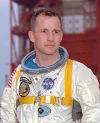
USAF:n kapteeni James Whiten maalliset jäännökset löytyivät Laosista. White menehtyi taistelulennolla marraskuussa 1969. Koneena toimi F-105 -hävittäjäpommittaja.
http://www.dpaa.mil/News-Stories/Re...ing-from-the-vietnam-war-accounted-for-white/
https://www.findagrave.com/cgi-bin/fg.cgi?page=gr&GRid=41895835
Liittyy avaruuteen niin, että tämän vanhempi veli oli ilmavoimien everstiluutnantti ja astronautti Edward White, joka suoritti ensimmäisen amerikkalaisen avaruuskävelyn ja joka menehtyi Apollo 1 -onnettomuudessa 1967.

NASA is on a mission to find all natural impact hazards to Earth and and determine a plan of action. To pose a threat, hazardous objects must be large enough and close enough to Earth. NASA detects and watches these objects with the help of observers across the globe, including both professional and amateur astronomers. NASA has successfully detected, tracked, and cataloged most of the largest near-Earth objects. NASA is working now on finding smaller objects to defend the planet against potential impact. NNSA is one of the Federal agencies with responsibilities for “planetary defense” or detecting and mitigating impact threats from potentially hazardous near-Earth objects, such as asteroids and comets. These efforts are part of an official national security focus for the United States.
Read more at https://nnsa.energy.gov/planetarydefense
Ariane 6 projekti etenee.
At the European spaceport in Kourou, French Guiana, the new launch facilities for ESA’s Ariane 6 launcher are being built. With the Ariane 6 launcher and the upgrade of the Vega to Vega C, Europe expands its launching capacities by creating versatile launchers that meet market demands. At the same time ESA supports both institutional missions and European industry as both Ariane 6 and Vega C will be fully European. With Ariane 6 and Vega C, Europe secures its independent access to space for years to come.
Marraskuu.
https://www.space.com/37668-spacex-first-falcon-heavy-launch-in-november.htmlSpaceX's new megarocket, the massive Falcon Heavy, will make its launch debut in November, according to the company's founder and CEO Elon Musk.
In Twitter and Instagram statements late Thursday (July 27), Musk announced the fall target for the Falcon Heavy's maiden flight.
"Falcon Heavy maiden launch this November," Musk wrote on Twitter. He did not reveal a specific target date for the launch, though it is expected to fly from Pad 39A at NASA's Kennedy Space Center in Cape Canaveral, Florida. SpaceX leases the pad from NASA and has been using it for Falcon 9 rocket launches
BarrelNut
Kenraali
USA:llahan on useita ohjustentorjuntajärjestelmiä, isommassa päässä GMD, pienemmässä päässä Patriot, ja siinä välissä THAAD/AEGIS. Muitakin varmaan on kehitteillä.
Mutta noiden testaaminen vaatii myös ballistisia maaliohjuksia, ja niissä hauskoja ovat nämä ilmalaukaistavat ohjukset. Eli ohjukset tiputetaan rahtikoneesta alas laskuvarjoilla, kuten alla:

Mutta noiden testaaminen vaatii myös ballistisia maaliohjuksia, ja niissä hauskoja ovat nämä ilmalaukaistavat ohjukset. Eli ohjukset tiputetaan rahtikoneesta alas laskuvarjoilla, kuten alla:

Elon-aikaa
 , joten... joulun välipäivinä jos tänä vuonna laisinkaan.
, joten... joulun välipäivinä jos tänä vuonna laisinkaan.http://www.spacedaily.com/reports/R...ng_Baikonur_Spaceport_Soon_Heres_Why_999.htmlRoscosmos and the Russian Ministry of Defense are likely to team up to facilitate the construction of the launch pad for the Angara heavy-lift carrier rockets, RIA Novosti contributor Andrei Stanavov writes, shedding light on why the Russian military is ready to give up using the Kazakhstan-based Baikonur cosmodrome.
Russia will soon stop launching its military satellites from the Kazakhstan-based Baikonur cosmodrome, and with good reason, RIA Novosti contributor Andrei Stanavov writes.
On Wednesday Russian Deputy Prime Minister Dmitry Rogozin announced that the first technological equipment for the launch of the Angara heavy-lift carrier rocket has been delivered to the Vostochny Space Center in Russian Far East.
"The first technological equipment for the Angara has arrived. It is in the assembly and testing facility," Rogozin told reporters at a meeting at the Vostochny cosmodrome.
According to the head of Russia's Roscosmos State Space Corporation, Igor Komarov, the corporation is ready to launch a modernized Angara-A5M super-heavy carrier rocket from the Vostochny cosmodrome in 2021.
Stanavov highlights that besides Roscosmos the Russian Defense Ministry is also interested in exploiting the heavy-lift rocket: the Angara-A5 is expected to replace the Proton and Soyuz space-launch vehicles not only for commercial but also for military purposes.
"While the launching of manned spacecraft carrying international crews and commercial satellites from the Baikonur [spaceport] looks rather innocuous, the situation with the Defense Ministry's vehicles is different: launches [of military spacecraft] from the territory of another state appear to be an extreme measure," the journalist elaborated.
